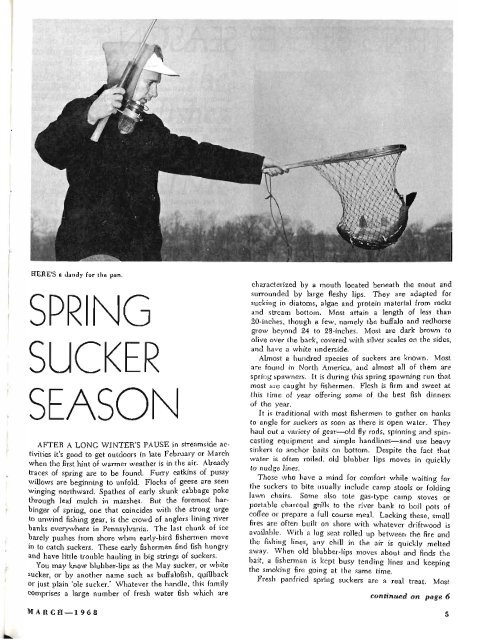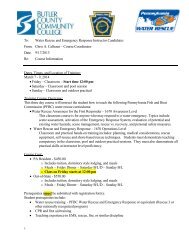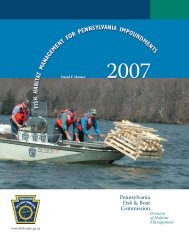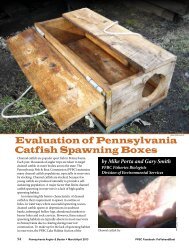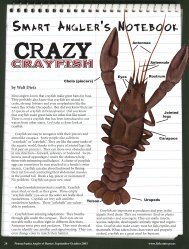march, 1968 - Pennsylvania Fish and Boat Commission
march, 1968 - Pennsylvania Fish and Boat Commission
march, 1968 - Pennsylvania Fish and Boat Commission
Create successful ePaper yourself
Turn your PDF publications into a flip-book with our unique Google optimized e-Paper software.
HERE'S a d<strong>and</strong>y for the pan.<br />
SPRING<br />
SUCKER<br />
SEASON<br />
AFTER A LONG WINTER'S PAUSE in streamside activities<br />
it's good to get outdoors in late February or March<br />
when the first hint of warmer weather is in the air. Already<br />
traces of spring are to be found. Furry catkins of pussy<br />
willows are beginning to unfold. Flocks of geese are seen<br />
winging northward. Spathes of early skunk cabbage poke<br />
through leaf mulch in marshes. But the foremost harbinger<br />
of spring, one that coincides with the strong urge<br />
to unwind fishing gear, is the crowd of anglers lining river<br />
banks everywhere in <strong>Pennsylvania</strong>. The last chunk of ice<br />
barely pushes from shore when early-bird fishermen move<br />
in to catch suckers. These early fishermen find fish hungry<br />
<strong>and</strong> have little trouble hauling in big strings of suckers.<br />
You may know blubber-lips as the May sucker, or white<br />
sucker, or by another name such as buffalofish, quillback<br />
or just plain 'ole sucker.' Whatever the h<strong>and</strong>le, this family<br />
comprises a large number of fresh water fish which are<br />
characterized by a mouth located beneath the snout <strong>and</strong><br />
surrounded by large fleshy lips. They are adapted for<br />
sucking in diatoms, algae <strong>and</strong> protein material from rocks<br />
<strong>and</strong> stream bottom. Most attain a length of less than<br />
20-inches, though a few, namely the buffalo <strong>and</strong> redhorse<br />
grow beyond 24 to 28-inches. Most are dark brown to<br />
olive over the back, covered with silver scales on the sides,<br />
<strong>and</strong> have a white underside.<br />
Almost a hundred species of suckers are known. Most<br />
are found in North America, <strong>and</strong> almost all of them are<br />
spring spawners. It is during this spring spawning run that<br />
most are caught by fishermen. Flesh is firm <strong>and</strong> sweet at<br />
this time of year offering some of the best fish dinners<br />
of the year.<br />
It is traditional with most fishermen to gather on banks<br />
to angle for suckers as soon as there is open water. They<br />
haul out a variety of gear—old fly rods, spinning <strong>and</strong> spincasting<br />
equipment <strong>and</strong> simple h<strong>and</strong>lines—<strong>and</strong> use heavy<br />
sinkers to anchor baits on bottom. Despite the fact that<br />
water is often roiled, old blubber lips moves in quickly<br />
to nudge lines.<br />
Those who have a mind for comfort while waiting for<br />
the suckers to bite usually include camp stools or folding<br />
lawn chairs. Some also tote gas-type camp stoves or<br />
portable charcoal grills to the river bank to boil pots of<br />
coffee or prepare a full course meal. Lacking these, small<br />
fires are often built on shore with whatever driftwood is<br />
available. With a log seat rolled up between the fire <strong>and</strong><br />
the fishing lines, any chill in the air is quickly melted<br />
away. When old blubber-lips moves about <strong>and</strong> finds the<br />
bait, a fisherman is kept busy tending lines <strong>and</strong> keeping<br />
the smoking fire going at the same time.<br />
Fresh panfried spring suckers are a real treat. Most<br />
continued on page 6<br />
MARCH —1 968 5


